Cooking Is A Family Affair In Alex Guarnaschelli's New Cookbook – Exclusive Interview
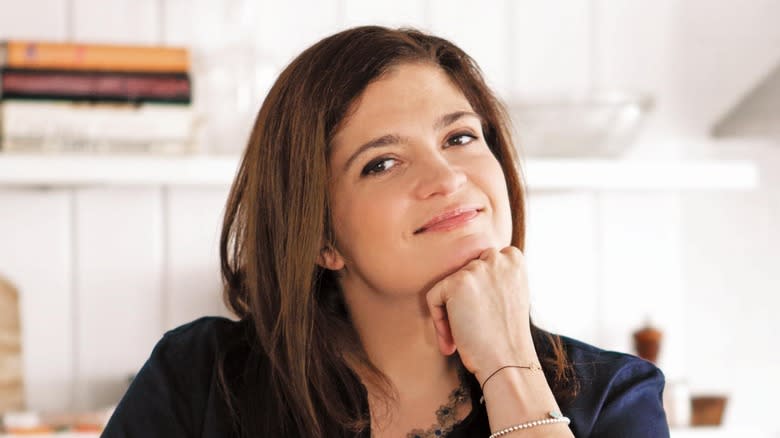
- Oops!Something went wrong.Please try again later.
Families have gathered around food for centuries. Passing down recipes and experimenting in the kitchen brings together and connects generations of eaters. It is no surprise, then, that Ava Clark, the teenage daughter of acclaimed chef Alex Guarnaschelli, would find a creative outlet in the kitchen. While Guarnaschelli never pushed Clark to follow in her footsteps, the kitchen became a natural place for the two to bond. The product of their partnership is the new book "Cook It Up: Bold Moves for Family Foods."
While some might think that Guarnashcelli is the lead on this book, it is clearly a collaborative effort, with recipes from Clark and Guarnaschelli. "Cook It Up" brings together family classics as well as bold new takes on traditional recipes, interspersed with tips and tricks that can only be acquired after a prominent career. We sat down with Guarnaschelli for an exclusive interview to discuss her and Clark's new book and what we can learn from the talented family.
Read more: Cookbooks Everyone Should Have
The Family That Cooks Together
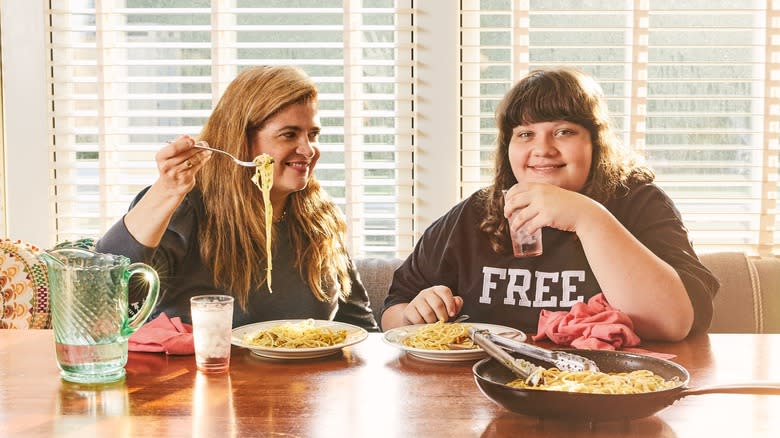
What inspired you and your daughter, Ava, to write a cookbook together?
I come from a heavy food background, and I haven't been pushing food or cooking on Ava, because I think she needs to find it in her own natural way. I've found in the last couple of years that she goes in the kitchen and makes her own breakfast, makes her own school lunches, and everything like that.
I was noticing that she enjoys a lot of family recipes from my mother and me, but she also has a lot of her own, and she definitely has her own style when it comes to cooking and putting together food. I thought, if we do this, I want it to feel true and organic. I don't want it to feel forced. I asked her, and she said, "I really want to do my own recipes, Mom." I said that's perfect [and] that I don't think it'll work any other way.
So we pieced together the book. I said, "Why don't you bring me a lot of the things that interest you, and we can start to build a table of contents and a recipe list around that," because I felt like there were so many things that I could pick. I wanted it to begin with her voice, and then add mine on to get that genuine feeling of how a 16-year-old navigates the kitchen, or a 14-year-old, 12-year-old, 18, 10. It came together like that, like the pieces of a puzzle on a coffee table, and we just put them together, if that makes sense.
Is there any particular recipe in here that is a favorite or has a particularly strong meaning for either you or Ava?
When we went through the book when it was done, she said [about certain recipes], "This is so me" and "This is so you." I think when she finally saw the finished book, that's when she, in her way, allocated ... It was like a monopoly board. You get these avenues, and I get the railroads. The ones that mean a lot to me are the ones that she did that have absolutely nothing to do with me, because there are a lot that are a mix and some that are mine. The ones that stand out are a couple that she made because of things my mother loved to eat and Ava ate. There's a Dan Dan Noodle recipe and a marinated cucumber recipe. These are things my mother loved to eat, and Ava and my mother would eat them together.
My mother loved anything that was super tasty. My mom was literally what they call a supertaster. She literally had that extra set of taste buds, and Ava loved that. These were recipes that Ava wrote and tested as an homage to my mother. They're also things that she loves to eat. For me, those are two shining examples of this beautiful multi-generational dialogue that we have with food.
Friends And Finds

In the book, you mentioned that Ava has introduced you to cooking trends and TikTok personalities. Do you have a favorite trend or TikTok personality that she's introduced you to?
This one in particular is from Instagram, but I believe he's on TikTok too — Jake Cohen. He does savory food, but he also does a lot of baking. She'll show me stuff [that] she'll make, and I'll say, "Where did you get this?" She's been making Jake Cohen's recipes of late, and I love those. She just made his challah recipe. Ava's grandparents on her father's side are Jewish, so she has this other thread in her heritage that she enjoys exploring. You can see a little bit of that. She has a latke recipe and some other recipes that she makes with her other grandmother on the holidays. It's interesting how this TikTok thread seems to emanate outward from traditions she's learning at home from her family.
Bobby Flay also gets a shout-out in your acknowledgments. Do you have a particularly memorable meal that he has cooked for you?
I've had the privilege of eating many meals from his cooking directly, and he is a tremendous cook. I know we say he's an incredible chef and an icon, but he's also a tremendous cook. I've had many I love, but once he made me — just a couple years ago, if not [more recently] — pasta with sea urchin and a grilled pork chop. It was ... I don't know. I can't explain. No words. I chewed silently and stared into the horizon. That's what you do when you eat something that's perfect.
So he's a mentor. I like that he loves to cook for people. He really does. I enjoy that.
Cooking Up Tradition
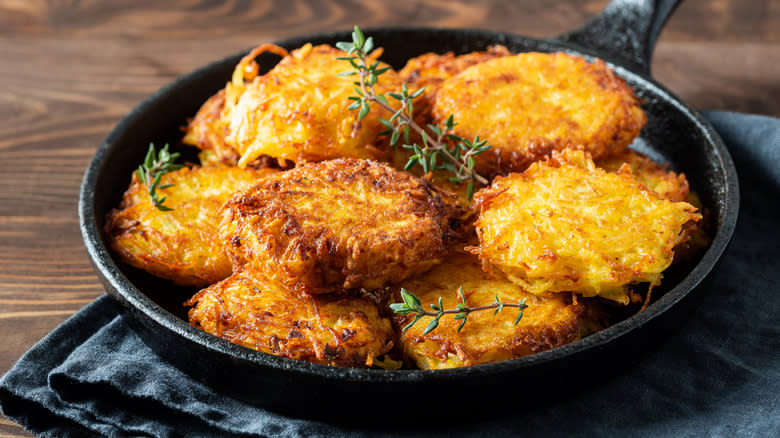
[In] one of your daughter's recipes, the Nana Ida's latkes, after pan frying, the whole skillet gets placed in the oven with the latkes in it. What do you think this does for the latkes, and how is this better than placing them on a new, dry pan and into the oven, or just out on the counter?
We wouldn't just put them on the counter, because they're not fully cooked. We put them in the oven in the hot oil that already has the hot pan and the momentum from the heat[ed] stove top, and we continue that conversation with all-around heat of the oven.
Does this give you a crispier latke than just pan-frying it on the stove top?
Not necessarily. You're looking to cook the interior more than anything and make sure it's cooked through. The crisping happens in the browning in the oil. It's the shallow frying stove top that drives the crispy bus.
There is great debate on which side of the grater to use for potatoes when making latkes. The recipe in the book says to use the largest hole. Why is that?
If you grated it on the smallest hole, it likely wouldn't even create a shredded potato you could use.
All Down To Science
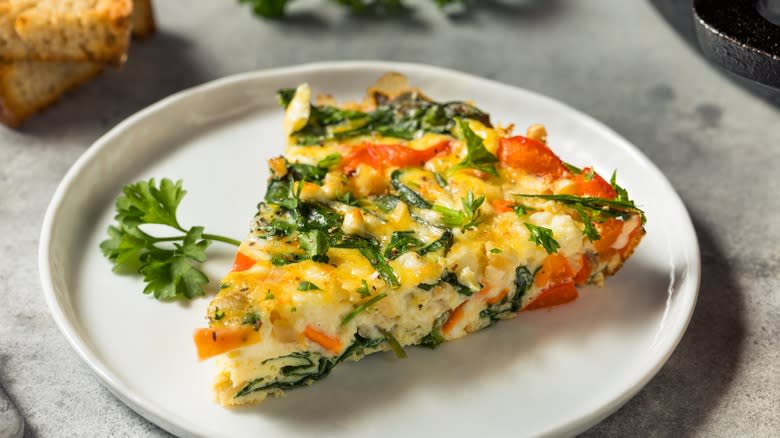
In your frittata recipe, you specify using water to achieve the lightest, fluffiest eggs over using something like milk or cream. Why does water create a better egg?
Scientifically, it creates the fluff factor. It's a fact. It's not me being clever. It comes from a chef from Julia Child's time — Dione Lucas. There's an iconic restaurant in Los Angeles, Joan's on Third, and Joan, the owner, is there every day making omelets. She served me an omelet, and I said, "This feels like my mom made this."
She said, "I put water in the omelet instead of milk or cream because it makes it fluffier." It was like a full-circle moment for me because it was what my mother always said to me growing up, and I had never had anybody else say it. She said, "Dione Lucas always said this." I said, there is the full-circle moment. I'd like to be clever and tell you it's my brilliant idea, but we must put credit where credit is due.
You also have a unique method for spicing your meatballs. Can you share more on your tips on spreading out the meat?
The less you mix [and] work the meat, the more tender the result. It's like when you add liquid to flour. You start working the gluten, and it toughens the cake or the bread or whatever else. It's the same for meat, especially ground meat that is already highly processed. First, it's cut into a chunk, and then it was put through a grinder.
People think "processed" means junk food only, but "processing" as a word also applies to putting a food or an ingredient through its paces before it gets to you in any form. The meat's been cut and then ground, and now you're going to mix it and work it, and that toughens it even more. If you're able to just spread it out, distribute the seasoning, and then gently mix it together far less, you'll get a more tender meatball, and we like that. Less work, better results.
The Perfect Caramel
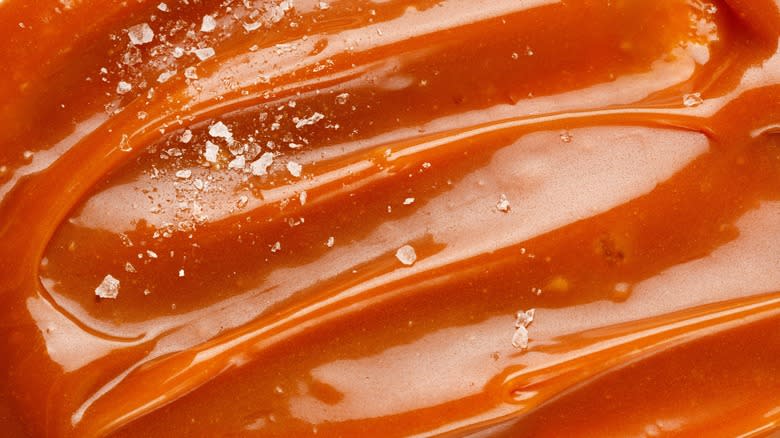
The book also describes caramel as one of the simplest yet hardest items to make. What are your tips for making great caramel?
First of all, you need a clean pan because any dirt or impurity in the pan can interrupt and cause the sugar to crystallize. To that end, you don't want to stir it with any utensils for the same reason. Caramel is a leap of faith because you just put sugar in the pan, and gently heat it, and watch it turn that amber color. The simpler, the better, so to speak, in terms of the methodology. Don't stir it. Don't fuss with it. Just believe it's going to happen.
Also, the reason people are intimidated is, rightfully so, because caramel can give you quite a memorable burn. It's like maybe watching a great white shark at the aquarium. You're looking at other fish, but you always know where the great white is. With caramel on the stove, you want to be passive with it in many ways but also constantly aware of where it's at.
For cleaning tips, once you've made your caramel and used it in any form, put the pot in the sink, pour water over the caramel, fill your pot halfway, and simmer it a couple minutes on the stove to clean the caramel off with hot water instead of scrubbing it up.
Working With White Chocolate
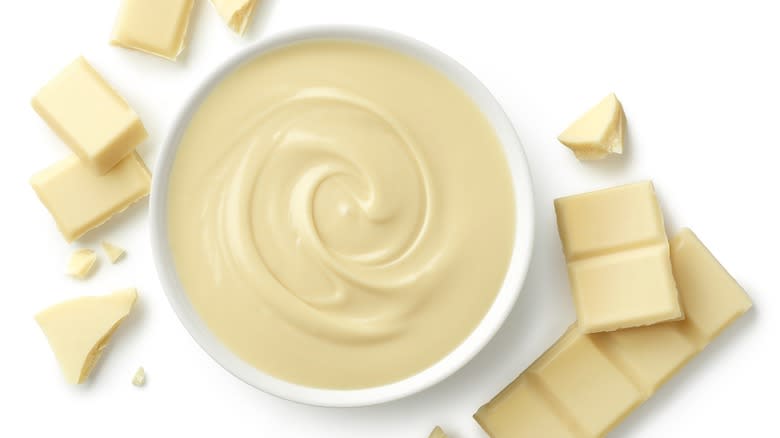
White chocolate is also notoriously difficult to deal with, and it makes an appearance in the black and white cupcakes. What are your tips for getting the white chocolate just right?
Cutting white chocolate from a block or a bar instead of buying the more processed chips can create a good insurance policy. You have to buy good quality, like chocolate from a brand you trust. I don't think it's an ingredient where you can skimp. If you need to skimp, probably safer to use dark chocolate.
Don't overheat it. Know that it's got a ton of cocoa butter in it, and it's high fat, so if you're adding other fats to it, like cream or butter or milk, think about that for a minute. You don't want to add that on any extreme heat. You don't want to add ice-cold cream to warm white chocolate. You want to keep temperatures similar. Also, if you're melting the chocolate and adding things to it to make, for example, a ganache, [it] will be glossier as a result.
Do you have a brand of white chocolate you prefer?
No, I don't. I like a lot of them that are out at the store. Go to your baking aisle as opposed to going to the counter where the candy bars and stuff are. Look at your baking aisle, and that's probably where you're going to find the better stuff.
Squished Squash
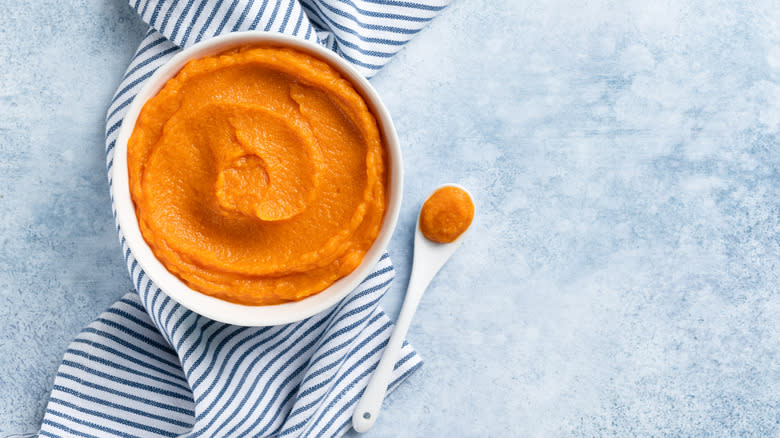
In your pumpkin bread recipe, you specify using pumpkin puree. Why is pumpkin puree, in some cases, a better option than using a freshly made pumpkin-pureed squash?
I don't necessarily say it has to be better. Either would do, but fresh squash can often be very watery. If you're cooking it fresh and you don't cook it as much as a canned puree has been [cooked], and you have more water, that water is going to drastically affect, for example, your pumpkin pie. Even [for] a pumpkin custard or anything, I'd rather rely on the consistency of the pumpkin puree in the can. I also think it tastes better. I don't know why, whether it's just from sitting in the can, sometimes. People turn their nose up at canned food a little bit too often for my taste. Year after year, the canned pumpkin is just the way it is.
By the way, roast fresh squash and eat it. A giant bowl of roasted squash from your local market — I love it. But if you're baking and doing things like custards, pies, and cakes, the pumpkin puree is a safer bet for those types of recipes.
Pantry Staples
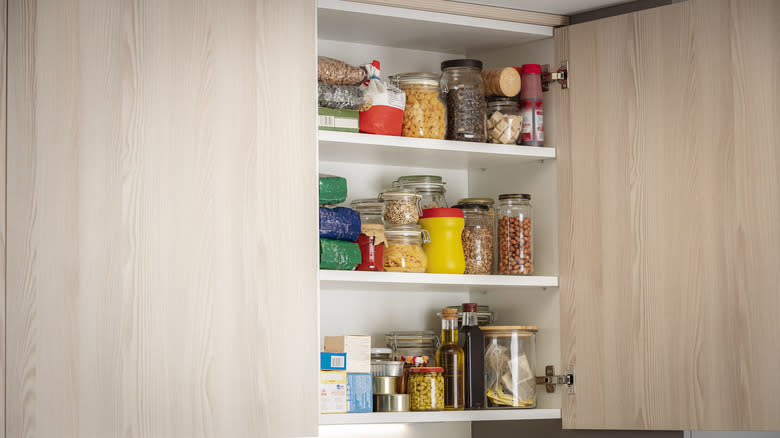
The book does offer a whole section on pantry items. Do you have any pantry staples that you always have to have on hand?
Mustard, rice wine vinegar, red wine vinegar, vanilla. A little bottle of vanilla goes a long way. Those are some of mine. You see there too, a lot of the things that my daughter loves are there.
Do you know any of the ones that Ava has to have?
It should be right there in the introduction. I'm trying to think what she uses most often. She really uses sesame seeds, rice wine vinegar. She loves anchovies, like a jar of anchovies and oil. She adds that to a lot of her recipes. Chickpeas are a great source of protein that we turn to a lot to make something more filling or delicious. We like to make homemade hummus. We love tahini, also, just the tahini paste -- such a good way to add richness to any number of things without using dairy. I know a lot of people want to avoid dairy. We love unsweetened coconut milk. That's almost a soup -- just opening the can and adding a few vegetables is so delicious.
Souped-Up Ramen
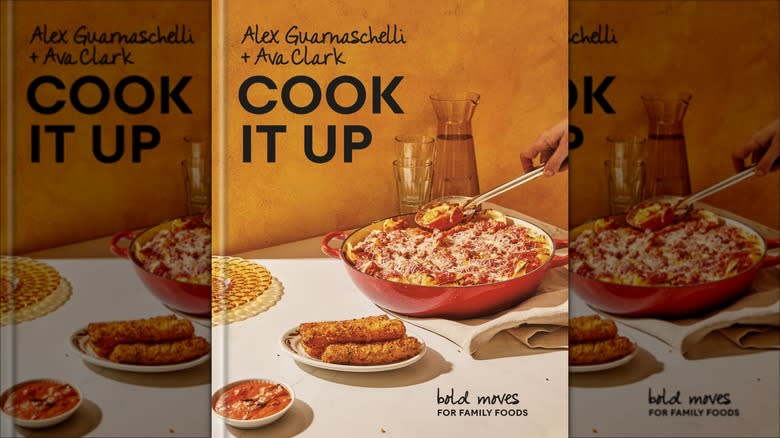
Ava's recipe for souped-up ramen is a fun addition to the book. She mentioned that when you were in college, you would make it with no additions and eat the instant ramen the way it is. Do you have any ways that you like to elevate it now?
I like to add anything fresh. That's the type of recipe where you go in your fridge and you're like, "Oh, look what I'm going to use." I don't know much that would be wrong there. Whether it's scallions, onions, and garlic, whether it's a couple of carrots and some sliced celery from the bottom of your crisper drawer. I've added leftover salad greens in there. You always seem to have a handful of arugula or a pinch of spinach or something like that. I've even added chopped-up iceberg lettuce for texture. The umami nature of the ramen and those noodles [is] waiting for anything you're going to throw at it.
"Cook It Up," by Alex Guarnaschelli and Ava Clark, is available now.
This interview has been edited for clarity.
Read the original article on Tasting Table.

